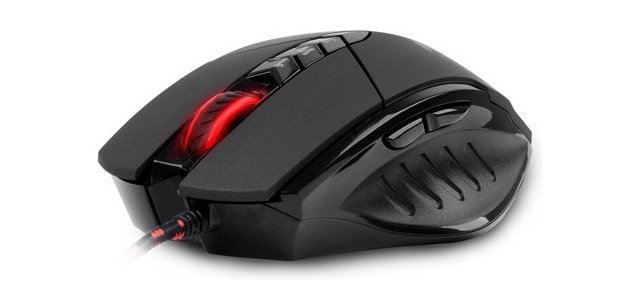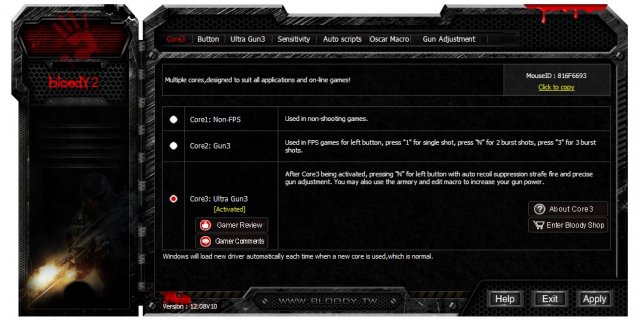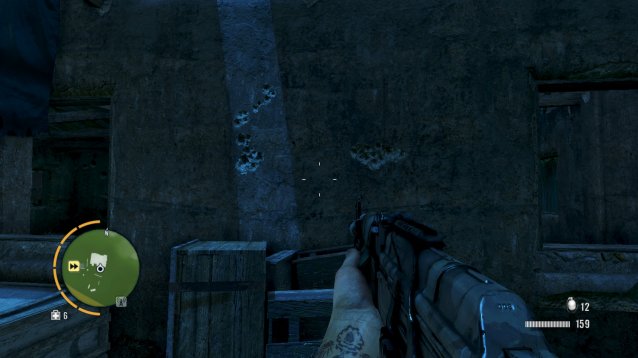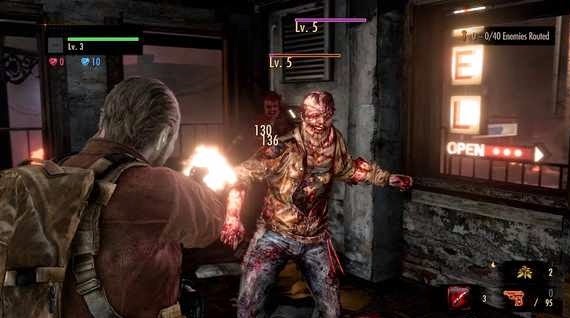


In the large catalogue of computer and console peripherals, there's always been a wide number marketed exclusively for the hardcore gamer. Such devices claim to increase one's abilities, guaranteeing victory over their foes if only they would use this mouse or controller. They tend have fanciful LED lights, multiple new and configurable buttons, and high sensitivity levels. And while some may offer tangible benefits, at the end of the day player skill generally wins out over a player's peripheral. A4Tech intends to change that with their Bloody Multi-Core line of gaming mice, advertising that their products actually do what others don't — for better or worse — by improving aim through its "multi-core" system and "auto recoil suppression" and "trajectory adjustment" features. It's a bold statement, and one that left me not a little suspicious and skeptical. But after spending a week with their Gun3 V7 wired mouse, it was a device that ultimately left me surprised.
The packaging, however, did little to alleviate that initial skepticism. It's doesn't necessarily look cheap, but it doesn't look professional, either. Each side features a bloody handprint motif, with more blood dripping off text and borders. Its main features are all prominently listed and described, with the usual bravado about faster response times and improved accuracy, though unfortunately they're written in somewhat broken English. "Let you defeat enemy and win the games effortlessly!" and "Let you log in on-line games freely and enjoy all the gaming stunts!" may not sell the product to everyone, certainly not to me.
Thankfully, its contents fare much better. Inside is the usual assortment of goods, plus a few extras - a small usage guide, the driver installation disc, stickers, a cleaning cloth and extra teflon mouse feet. And of course there's the mouse itself, which looks and feels of a higher caliber than its price.
Comparitvely, it shares similar ergonomics to Logitech's quality gaming mice, such as the G700, with their sloping thumb rests. It's a comfortable general design that I love with my G500, and I'm glad to see it reproduced here. The Gun3 V7 goes a step further, however, by adding what feels like soft rubber to the entire top length of the mouse and a portruding pinky wrest on the right. The latter felt extremely awkward for the first day of use, to the point of me utterly disliking holding the mouse, but my hand adjusted and now it's hard to imagine it not being there.
The underside is a little different, as well. Instead of a recessed laser, the Gun3's hole is completely flat. This prevents dust or hair from clogging it up. The included cleaning cloth may not even be necessary. The overall design is also notably sleeker than the Logitech mice I've been comparing it to. Its sharper lines are attractive and scream for attention. In addition, the lights illuminating the scroll wheel and a throbbing, bloody handprint on its lower half — in stark contrast to the black of the mouse — make it hard not to look at.
But it's not without its share of blemishes. There are only two programmable buttons on the thumb side of the mouse, and they feel a little cheap. The other three added buttons, which change functionality based the selected "core" — more on that later in the review — are in a vertical column directly below the scroll wheel. It's an awkward position for use as regular, programmable buttons. The Gun3 V7 does offer the ability to change sensitivity levels with a double tap of one button and the flick of the wheel, but sadly there's no indicator on the mouse itself. Lastly, the right mouse button was a little loose on the one supplied to us, making audible clangs whenever I would tap or lift my finger off it. While it wasn't enough to make me not want to use it, the noise was distracting.

The software, despite the name, the bloody images and the unintentionally hilarious descriptions, also defied my preconceived notions. It's a lightweight application, and not once did it crash through heavy use. Each page is superbly detailed and informative, with a wide number of features. Sensitivity can be configured within the software up to 3,200 DPI and into five segments, as well as four different polling rates. There's an option to create and even download macros from the official product page. It wouldn't be a modern gaming mouse if buttons couldn't be reprogrammed, too. Depending on which of the three cores is selected, nine buttons can be programmed, while six total are available in the other two cores.

And that brings us to the meat and potatoes of the product itself — the multi-core and recoil suppression features. The multi-core system is essentially three different modes selectable within the software that modifies abilities of the mouse itself. These are labeled "Core1", "Core2" and "Core3". The first acts just like any gaming mouse. The second and third cores change the functions of the buttons below the scroll wheel and how the mouse behaves when clicking them. These buttons, labeled "1", "N" and "3", cannot be re-programmed. Stay with me, it only gets more complex from here.
In Core2, those "N" and "3" buttons enable burst firing modes. And it works quite well. My assault rifle fired two- or three-shot bursts depending on which I selected, without the need for any special attachments. The "1" button always switched the weapon back to its normal firing state, in either of the two special core modes.
But it's in Core3 that has the controversial feature. Pressing "N" in this mode enables the vaunted auto recoil suppression and trajectory adjustment abilities of the mouse. The website and the packaging talk about guaranteeing headshot rates, eliminating finger fatigue and window judder, and show visual comparisons. It all sounds too good to be true. While some of those claims may be malarkey, the recoil suppression surprisingly works.

I tested all of the above features in a number of different games, such as Far Cry 3, Crysis 3, Call of Duty: Black Ops 2 and Borderlands 2. I did wall, movement, and general gameplay tests with several weapons. In every game, when aiming down the sights, the spread of my bullets were all centered and focused to a single spot. It eliminated the vertical climb of my weapons. And with single or burst firing weapons, enabling recoil suppression made them fully automatic.
Best of all, those functions could all be selected and adjusted without the software running, though unfortunately not the cores themselves. Double tapping "N" allowed me to adjust firing rates, select two recoil suppression techniques, and alter its strength. The feature basically compensates for vertical climb by pulling the weapon down without the player having to do that physically, so if a weapon has a stronger recoil, raising that value keeps it in check. It's fast and easy to do, though managing all these taps and adjustments can be overwhelming at first.
Unfortunately, its multi-core features also have a few rough edges and caveats. While the mouse may have the ability to use Core3, it doesn't come activated with its purchase, adding an extra 20 dollars to the total price in order to use its full functionality. It's downloadable content for hardware. Suffice to say, I don't approve of the practice.
And for the recoil suppression to work, it seems to rely on lowering the weapon's fire rate. That value can be adjusted, of course, but it never quite reached the same speed as when the suppression was off. And in one application, increasing the value to its maximum forced my weapon straight down when firing instead of keeping it centered.
It's not quite a plug-in-and-play feature, either. The default values worked fine for most weapons, but different guns do have different characteristics. It became necessary to adjust the settings again depending on what I was using. What worked for my AK-47 didn't work quite with my Mk 48 light machine gun, for example. In a game like Call of Duty, where players may be constantly switching weapons, that may not be ideal. Profiles can be made, but there didn't appear to be any way to select them on the fly. That rather defeats their purpose.
Finally, it goes without saying that this isn't exactly a fair device. It alters the way a weapon fires and how it behaves, giving players who use it a large advantage over those who don't. I wouldn't be surprised to see accusations of cheating fly.
A4Tech's awkwardly named Bloody Gun3 V7 gaming mouse leaves me somewhat conflicted. Its fit and finish is nice and it's comfortable to hold, but the loose, noisy right mouse button and lack of decently placed programmable buttons kept me reaching for my Logitech. Although it delivers on its multi-core and recoil suppression declarations, something I couldn't believe prior to using it myself, its unsporting nature and — depending on the application — constant adjustments are troublesome. I can't recommend it to those looking for a standard gaming mouse. But if there's someone out there interested in those features, wondering if its oddly described capabilities are real, I can confirm that they are not empty promises.




 Best PC Graphics in 2013: Screenshots in 4K Glory
Best PC Graphics in 2013: Screenshots in 4K Glory Find Your Fighter and win an official Street Fighter T-Shirt!
Find Your Fighter and win an official Street Fighter T-Shirt! Final Fantasy 13-2 Walkthrough
Final Fantasy 13-2 Walkthrough Nym’s Nightmare – Walkthrough [with Explanations]
Nym’s Nightmare – Walkthrough [with Explanations] Portal 2 Once Had Everything That Made it a Portal Game Cut Out
Portal 2 Once Had Everything That Made it a Portal Game Cut Out